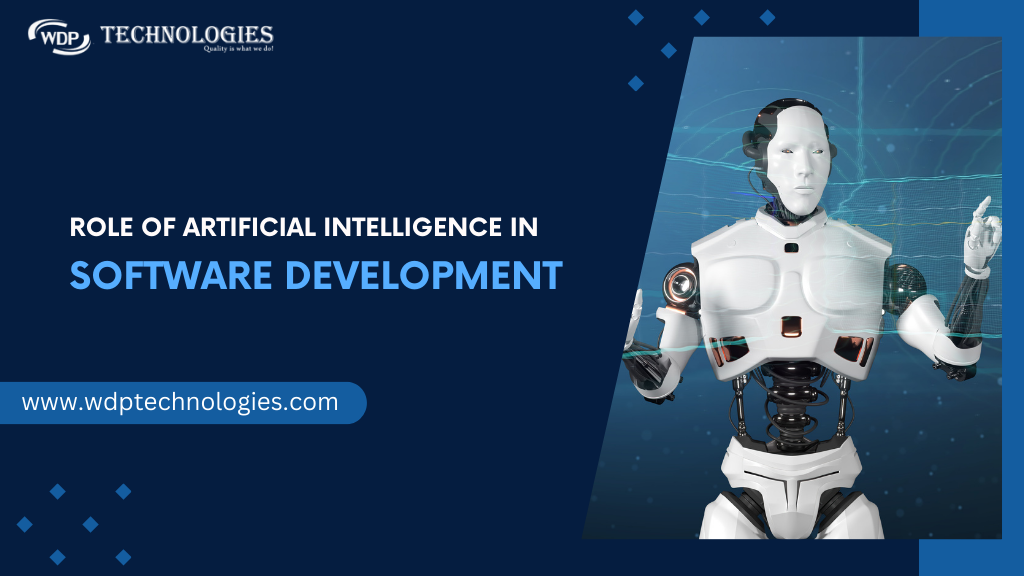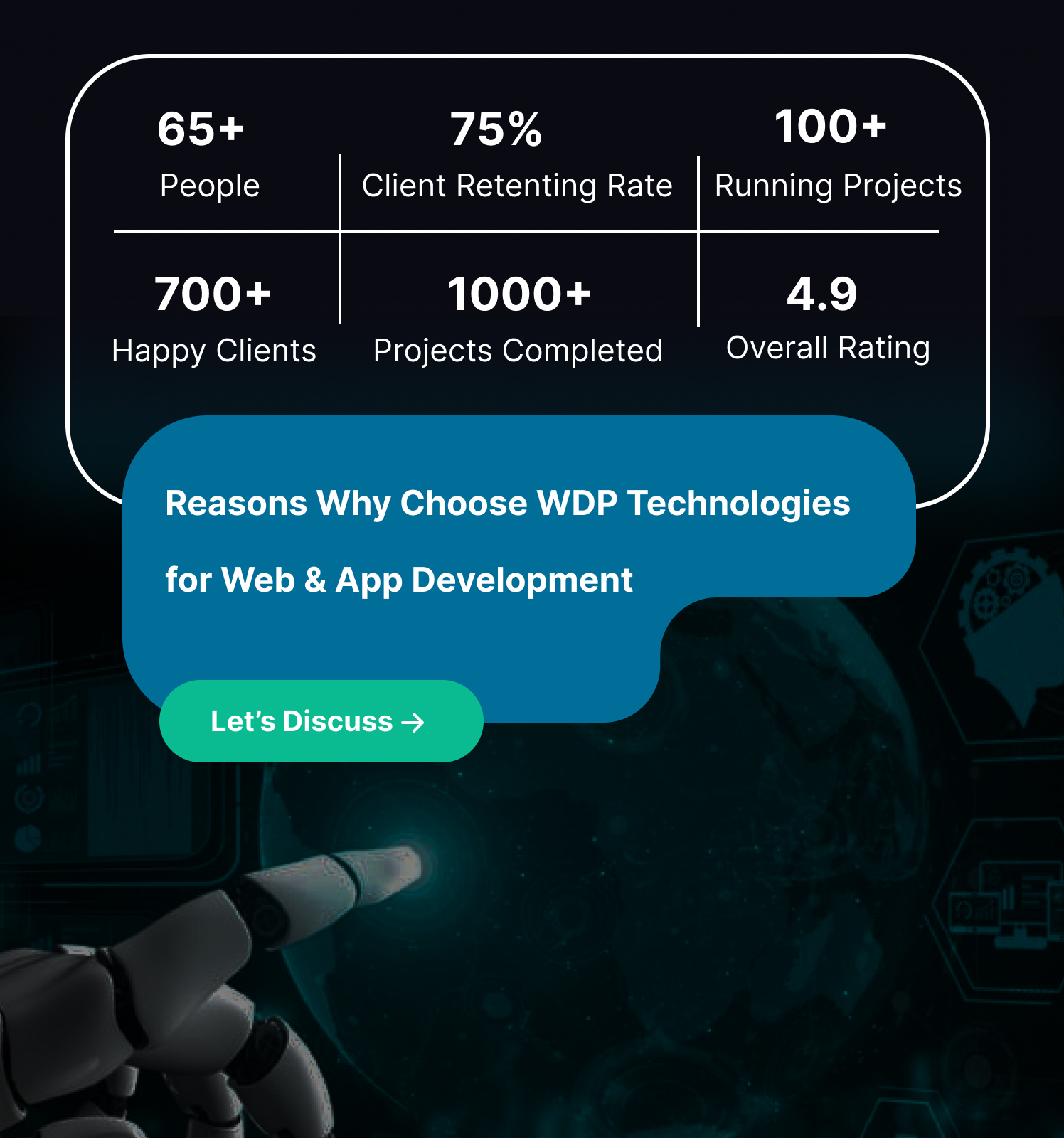Artificial Intelligence (AI) has emerged as a transformative force, offering new possibilities and efficiencies in various fields. One of the areas where AI has made a significant impact is in software development. By integrating AI into the development process, developers can streamline workflows, enhance productivity, and create more intelligent and adaptive software.
Integrating AI in software development lifecycle is essential for staying competitive in a rapidly evolving digital landscape. It streamlines processes, improves code quality, and opens up possibilities for creating more personalized and user-centric applications. This blog will explore how to effectively use AI in software development, covering various aspects from planning to deployment.
How AI is Transforming Software Development
The world of software development is seeing a surge in AI adoption, with numerous benefits and exciting growth potential. Here are some key statistics to showcase its impact:
- Global AI market size: $150.2 billion in 2023, projected to reach $190.61 billion by 2025 (CAGR of 36.62%).
- Generative AI in software development: Market size expected to reach $169.2 million by 2032 (CAGR of 21.4%).
- Global AI adoption: 35% of companies currently use AI, with 42% planning to integrate it in the future.
- Developer productivity: AI can reduce debugging and testing time by up to 70%.
- Cost-effectiveness: 54% of organizations report AI being cost-effective for their software development processes.
Key components of AI in software development:
The key components of Artificial Intelligence (AI) in software development encompass various techniques and technologies. Here is an elaboration on each component.
a. Machine Learning (ML):
Machine Learning is a subset of AI that focuses on developing algorithms allowing systems to learn from data and improve performance without explicit programming. ML enables applications to make predictions, classifications, and decisions based on patterns learned from training data. It involves algorithms like regression, decision trees, and neural networks.
b. Natural Language Processing:
NLP involves the interaction between computers and human language, enabling machines to understand, interpret, and generate human-like language. NLP is crucial for applications such as chatbots, language translation, sentiment analysis, and speech recognition. It allows software to process and respond to natural language input.
c. Computer Vision:
Computer Vision enables machines to interpret and understand visual information from the world, similar to human vision. Computer Vision is used in applications like image recognition, object detection, facial recognition, and video analysis. It allows software to analyze and make decisions based on visual data.
d. Expert Systems:
Expert Systems use a knowledge base of human expertise to solve problems in a specific domain.These systems emulate the decision-making abilities of a human expert, providing solutions and recommendations based on predefined rules and knowledge.
e. Speech Recognition:
Speech Recognition involves converting spoken language into written text, enabling machines to understand and interpret spoken words.This component is used in voice-activated systems, virtual assistants, and transcription services, enhancing human-machine interaction.
f. Robotics:
Robotics in AI involves the integration of intelligent algorithms and sensors into physical robots to perform tasks autonomously. AI-powered robotics is used in manufacturing, healthcare, and other industries for tasks ranging from assembly lines to surgical procedures.
g. Reinforcement Learning:
Reinforcement Learning is a type of machine learning where an agent learns to make decisions by interacting with an environment and receiving feedback in the form of rewards or penalties. Reinforcement Learning is used in scenarios where software needs to learn optimal strategies through trial and error, such as game playing and autonomous systems.
h. Knowledge Representation:
Knowledge Representation involves structuring information to make it understandable for AI systems, while Reasoning enables systems to draw conclusions from that knowledge. These components are essential for systems that need to store, organize, and utilize information to make informed decisions.
Real-world applications of AI in software development:
AI algorithms are used to analyze user behavior and preferences to provide personalized recommendations in applications like e-commerce, streaming services, and social media. AI, particularly computer vision and machine learning, plays a crucial role in enabling self-driving cars to navigate and make decisions based on real-time data from sensors.
a. Healthcare Diagnostics:
AI is used for image analysis in medical imaging, aiding in the diagnosis of diseases. Machine learning algorithms can analyze medical images like X-rays and MRIs to identify patterns and anomalies.
b. Fraud Detection:
AI algorithms are employed to detect patterns and anomalies in financial transactions, helping to identify potential fraudulent activities in real-time.
c. NLP in Chatbots:
NLP enables chatbots to understand and respond to human language, providing a conversational interface for customer support, information retrieval, and various other applications.
d. Predictive Maintenance:
AI is used to predict equipment failures and maintenance needs by analyzing sensor data from machines, reducing downtime and optimizing maintenance schedules in industries like manufacturing.
Advantages of Using AI in Software Development
Using Artificial Intelligence (AI) in software development offers numerous advantages, contributing to improved efficiency, enhanced capabilities, and innovative solutions. Here are 15 advantages of incorporating AI in software development:
1) Automation of Repetitive Tasks:
AI tools can automate routine and repetitive tasks, such as code formatting, simplifying common code patterns, and generating boilerplate code. This allows developers to focus on more complex and creative aspects of software development.
2) Faster Development Cycles:
AI accelerates development by automating various stages of the software development life cycle. Automated code generation, testing, and deployment tools help reduce the time it takes to bring a software project from conception to completion.
3) Improved Code Quality:
AI-powered static code analysis tools can identify potential issues, such as code smells and vulnerabilities, before the software is deployed. This leads to higher code quality, improved maintainability, and fewer post-deployment bugs.
4) Enhanced Predictive Analytics:
AI algorithms analyze historical data to identify patterns and trends, helping developers make informed decisions. Predictive analytics can be used to estimate future resource requirements, user behavior, and potential challenges during development.
5) Efficient Bug Detection & Resolution:
AI-driven testing tools use advanced techniques, including machine learning, to identify and fix bugs efficiently. Automated testing with AI helps ensure better code coverage and reduces the likelihood of undetected issues.
6) Optimized Resource Utilization:
AI algorithms analyze resource usage patterns in real-time, optimizing the allocation of computing resources. This leads to improved performance, cost savings, and efficient utilization of cloud infrastructure.
7) Personalized User Experiences:
AI enables software to analyze user behavior and preferences, providing personalized experiences. This personalization can include tailored recommendations, content, and user interfaces based on individual preferences.
8) NPL for Human-Machine Interaction:
NLP allows software to understand and respond to human language. This is particularly beneficial for chatbots, virtual assistants, and voice-activated systems, enhancing the natural and intuitive interaction between users and software.
9) Data Security and Fraud Prevention:
AI algorithms can detect anomalies and patterns indicative of security threats or fraudulent activities. This proactive approach enhances cybersecurity measures, helping to prevent data breaches and unauthorized access.
10) Automated Documentation:
AI tools can automatically generate documentation based on code changes, reducing the manual effort required for documentation. This ensures that documentation stays up-to-date with the evolving codebase.
11) Predictive Maintenance:
AI-driven predictive maintenance analyzes system data to anticipate potential issues and schedule maintenance activities. This minimizes downtime, improves system reliability, and extends the lifespan of software systems.
12) Facilitates CI and CD (CI/CD):
AI streamlines the CI/CD pipeline by automating testing, deployment, and monitoring processes. This results in a more efficient and reliable continuous integration and deployment workflow.
13) Efficient Data Management:
AI assists in managing large datasets efficiently. Techniques like data clustering, indexing, and automated data cleaning contribute to improved data quality and facilitate better analysis.
14) Scalability:
AI-designed applications are inherently scalable, adapting to varying workloads and demand. This scalability ensures optimal performance and responsiveness, even as the user base or data volume increases.
15) Innovative Solutions with ML:
Machine Learning enables the development of intelligent applications. This includes recommendation systems, natural language processing, and image recognition, providing innovative solutions that enhance user experiences and deliver advanced functionalities.
Read More: Effective Ways To Use AI In Ecommerce
Similar Blog : AI App Ideas
Integrating AI into the Software Development Lifecycle
Integrating Artificial Intelligence (AI) into the Software Development Lifecycle (SDLC) can bring numerous benefits, including improved efficiency, enhanced decision-making, and the ability to create more intelligent and adaptive applications. Here are some key steps and considerations for integrating AI into the SDLC:
a. Define Objectives and Use Cases:
Clearly define the objectives of incorporating AI into your software project. Identify specific use cases where AI can add value, such as natural language processing, image recognition, predictive analytics, or recommendation systems.
b. Data Collection and Preparation:
Collect relevant and high-quality data for training AI models.Clean, preprocess, and normalize the data to ensure it meets the requirements of your AI algorithms.
c. Select Appropriate AI Models:
Choose the right AI models based on the nature of your problem and the data available. Consider pre-trained models or building custom models, depending on your project requirements.
d. Development and Integration:
Develop and train your AI models, using frameworks like TensorFlow, PyTorch, or scikit-learn. Integrate AI components into your software architecture, ensuring seamless communication between AI modules and the rest of the application.
e. Continuous Testing:
Implement comprehensive testing for both traditional software components and AI modules. Conduct unit tests, integration tests, and system tests to ensure the reliability and robustness of the AI-driven features.
f. Ethical & Regulatory Considerations:
Address ethical considerations related to AI, such as bias, fairness, and transparency. Ensure compliance with relevant regulations and standards, especially if your application deals with sensitive data or industries with specific requirements.
g. Monitoring and Maintenance:
Implement monitoring mechanisms to track the performance of AI models in real-world scenarios. Establish a plan for regular model updates and improvements based on feedback and changing requirements.
h. User Training and Feedback:
Train end-users and stakeholders on how to interact with and benefit from AI-driven features. Collect user feedback to continuously refine and enhance the AI models and user experience.
i. Security Measures:
Implement security measures to protect AI models and data, especially if dealing with sensitive information. Regularly update and patch AI components to address security vulnerabilities.
j. Documentation:
Document the AI integration process, including model architectures, training methodologies, and deployment procedures. Provide clear documentation for developers, operations teams, and end-users.
k. Collaboration:
Foster collaboration between AI specialists, software developers, and domain experts throughout the SDLC. Ensure effective communication to bridge the gap between technical and non-technical stakeholders.
Challenges and Considerations for AI Implementation
a. Transparency & Accountability
Ensuring transparency in AI decision-making processes is essential. Developers should provide clear insights into how AI models make decisions, making it easier for users to understand and trust the technology. Additionally, establishing accountability for the outcomes of AI applications is crucial to address potential ethical concerns.
b. User Privacy
AI often involves processing large amounts of user data. Safeguarding user privacy is paramount, requiring strict adherence to data protection regulations and the implementation of robust security measures. Developers must prioritize anonymization and encryption techniques to protect sensitive information.
c. Bias Identification & Mitigation
Identifying and mitigating bias in AI algorithms is an ongoing challenge. Developers must actively monitor and audit algorithms to detect and rectify biases in training data and decision-making processes. Implementing fairness-aware machine learning techniques helps in minimizing discriminatory outcomes.
d. Representative Training Data
To reduce bias, it’s crucial to use diverse and representative training datasets. Incorporating data from a broad spectrum of sources helps ensure that AI models are exposed to a variety of scenarios, preventing the development of biased patterns.
f. Continuous Learning
The rapid evolution of AI technologies requires developers to engage in continuous learning. Staying updated on the latest advancements in machine learning, natural language processing, and other AI domains is essential. Employers can facilitate this by providing learning resources and encouraging participation in relevant training programs.
g. Interdisciplinary Collaboration
Developing AI-powered software often requires collaboration between developers, data scientists, ethicists, and domain experts. Encouraging interdisciplinary teamwork fosters a holistic approach to AI development, incorporating diverse perspectives and skills.
Successful Implementations of AI in Software Development
a. Google’s AutoML
Google’s AutoML exemplifies successful AI implementation in software development. It allows developers, even without extensive machine learning expertise, to create high-quality custom machine learning models. This has streamlined the development process, making machine learning more accessible and efficient.
b. GitHub Copilot
GitHub Copilot, powered by OpenAI’s Codex, is an AI-powered code completion tool. It has transformed the coding experience by suggesting entire lines or blocks of code as developers type. This not only accelerates coding but also enhances code quality and consistency.
Conclusion:
Integrating AI in software development is a dynamic and iterative process that requires careful planning and implementation. By leveraging technologies, AI developers can create more efficient, adaptive, and intelligent software solutions that meet the ever-growing demands of the digital era. Stay updated on the latest advancements in AI and continuously explore new possibilities to enhance your software development practices.












